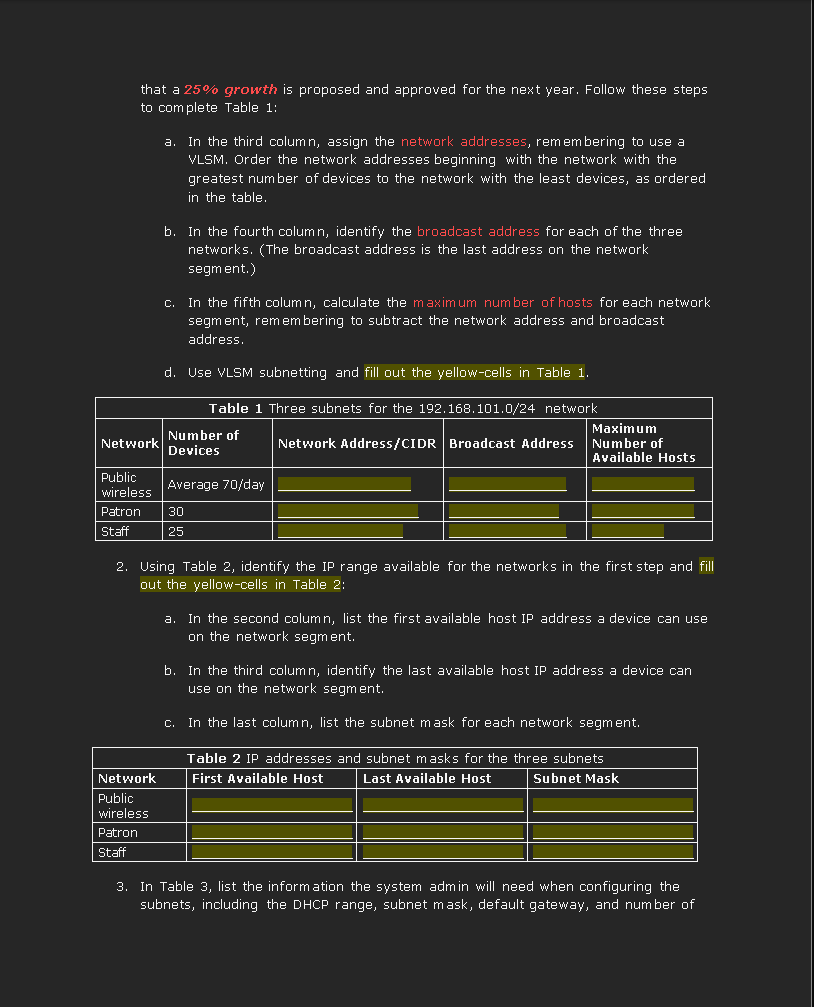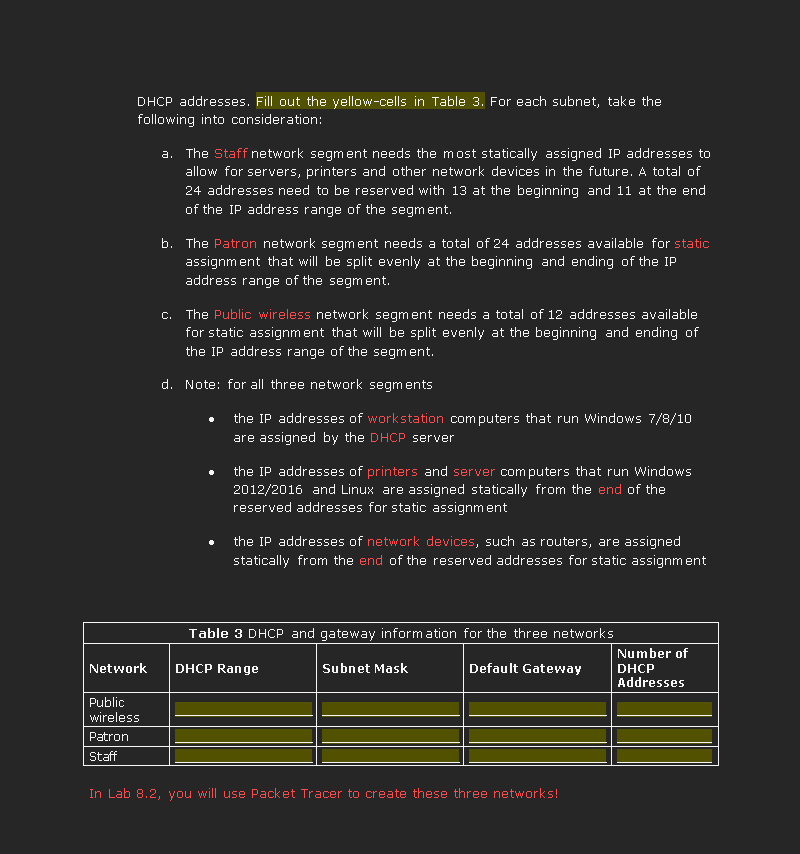Answered step by step
Verified Expert Solution
Question
1 Approved Answer
The goal of this lab is to segment a given network address using VLSM (Variable Length Subnet Mask). After completing this lab, you will



The goal of this lab is to segment a given network address using VLSM (Variable Length Subnet Mask). After completing this lab, you will be able to: Calculate subnets Materials Required This lab requires the following: Pencil and paper to perform subnet calculations Lab Preparation There is no preparation for this lab. ESTIMATED COMPLETION TIME: 60 MINUTES Activity Background A well-designed network should work transparently for the end users, allowing them to connect to the various types of resources available on the LAN (local area network). This lab will examine a small library network in which three separate networks will be created using a single router and switch. The network needs to be segmented for a staff network, patron network, and public wireless network using a VLSM (variable length subnet mask). The material related to the VLSM subnetting can be found at page 49 of the PowerPoint Presentation and at page 457 of the textbook. Activity Follow these steps to create a network scheme: 1. The library's system administrator wants to segment the 192.168.101.0/24 network into three separate networks. Table 1 shows the number of devices for each network required for the current year. When you work out the solution, you must consider that a 25% growth is proposed and approved for the next year. Follow these steps to complete Table 1: Network Public wireless Patron Staff a. In the third column, assign the network addresses, remembering to use a VLSM. Order the network addresses beginning with the network with the greatest number of devices to the network with the least devices, as ordered in the table. Network Public wireless Patron Staff b. In the fourth column, identify the broadcast address for each of the three networks. (The broadcast address is the last address on the network segment.) c. In the fifth column, calculate the maximum number of hosts for each network segment, remembering to subtract the network address and broadcast address. d. Use VLSM subnetting and fill out the yellow-cells in Table 1. Table 1 Three subnets for the 192.168.101.0/24 network Number of Devices Average 70/day 30 25 Maximum Network Address/CIDR Broadcast Address Number of Available Hosts 2. Using Table 2, identify the IP range available for the networks in the first step and fill out the yellow-cells in Table 2: a. In the second column, list the first available host IP address a device can use on the network segment. b. In the third column, identify the last available host IP address a device can use on the network segment. c. In the last column, list the subnet mask for each network segment. Table 2 IP addresses and subnet masks for the three subnets First Available Host Last Available Host Subnet Mask 3. In Table 3, list the information the system admin will need when configuring the subnets, including the DHCP range, subnet mask, default gateway, and number of DHCP addresses. Fill out the yellow-cells in Table 3. For each subnet, take the following into consideration: a. The Staff network segment needs the most statically assigned IP addresses to allow for servers, printers and other network devices in the future. A total of Public wireless Patron Staff 24 addresses need to be reserved with 13 at the beginning and 11 at the end of the IP address range of the segment. b. The Patron network segment needs a total of 24 addresses available for static assignment that will be split evenly at the beginning and ending of the IP address range of the segment. c. The Public wireless network segment needs a total of 12 addresses available for static assignment that will be split evenly at the beginning and ending of the IP address range of the segment. d. Note: for all three network segments the IP addresses of workstation computers that run Windows 7/8/10 are assigned by the DHCP server the IP addresses of printers and server computers that run Windows 2012/2016 and Linux are assigned statically from the end of the reserved addresses for static assignment the IP addresses of network devices, such as routers, are assigned statically from the end of the reserved addresses for static assignment Table 3 DHCP and gateway information for the three networks Network DHCP Range Subnet Mask Default Gateway In Lab 8.2, you will use Packet Tracer to create these three networks! Number of DHCP Addresses
Step by Step Solution
There are 3 Steps involved in it
Step: 1
1 This table provides the necessary ...
Get Instant Access to Expert-Tailored Solutions
See step-by-step solutions with expert insights and AI powered tools for academic success
Step: 2

Step: 3

Ace Your Homework with AI
Get the answers you need in no time with our AI-driven, step-by-step assistance
Get Started


